#afro cuban music
Text
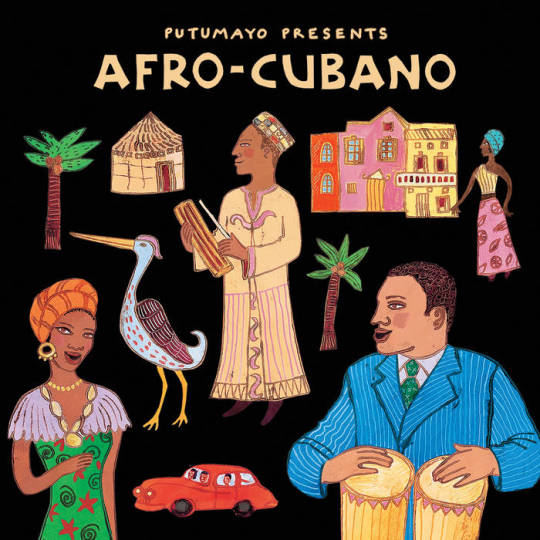
Music of African heritage in Cuba derives from the musical traditions of the many ethnic groups from different parts of West and Central Africa that were brought to Cuba as slaves between the 16th and 19th centuries. Members of some of these groups formed their own ethnic associations or cabildos, in which cultural traditions were conserved, including musical ones. Music of African heritage, along with considerable Iberian (Spanish) musical elements, forms the fulcrum of Cuban music.
Much of this music is associated with traditional African religion – Lucumi, Palo, and others – and preserves the languages formerly used in the African homelands. The music is passed on by oral tradition and is often performed in private gatherings difficult for outsiders to access. Lacking melodic instruments, the music instead features polyrhythmic percussion, voice (call-and-response), and dance. As with other musically renowned New World nations such as the United States, Brazil and Jamaica, Cuban music represents a profound African musical heritage.

Clearly, the origin of African groups in Cuba is due to the island's long history of slavery. Compared to the USA, slavery started in Cuba much earlier and continued for decades afterwards. Cuba was the last country in the Americas to abolish the importation of slaves, and the second last to free the slaves. In 1807 the British Parliament outlawed slavery, and from then on the British Navy acted to intercept Portuguese and Spanish slave ships. By 1860 the trade with Cuba was almost extinguished; the last slave ship to Cuba was in 1873. The abolition of slavery was announced by the Spanish Crown in 1880, and put into effect in 1886. Two years later, Brazil abolished slavery.
Although the exact number of slaves from each African culture will never be known, most came from one of these groups, which are listed in rough order of their cultural impact in Cuba:
The Congolese from the Congo Basin and SW Africa. Many ethnic groups were involved, all called Congos in Cuba. Their religion is called Palo. Probably the most numerous group, with a huge influence on Cuban music.
The Oyó or Yoruba from modern Nigeria, known in Cuba as Lucumí. Their religion is known as Regla de Ocha (roughly, 'the way of the spirits') and its syncretic version is known as Santería. Culturally of great significance.
The Kalabars from the Southeastern part of Nigeria and also in some part of Cameroon, whom were taken from the Bight of Biafra. These sub Igbo and Ijaw groups are known in Cuba as Carabali,and their religious organization as Abakuá. The street name for them in Cuba was Ñáñigos.
The Dahomey, from Benin. They were the Fon, known as Arará in Cuba. The Dahomeys were a powerful group who practised human sacrifice and slavery long before Europeans arrived, and allegedly even more so during the Atlantic slave trade.
Haiti immigrants to Cuba arrived at various times up to the present day. Leaving aside the French, who also came, the Africans from Haiti were a mixture of groups who usually spoke creolized French: and religion was known as vodú.
From part of modern Liberia and Côte d'Ivoire came the Gangá.
Senegambian people (Senegal, the Gambia), but including many brought from Sudan by the Arab slavers, were known by a catch-all word: Mandinga. The famous musical phrase Kikiribu Mandinga! refers to them.
Subsequent organization
The roots of most Afro-Cuban musical forms lie in the cabildos, self-organized social clubs for the African slaves, and separate cabildos for separate cultures. The cabildos were formed mainly from four groups: the Yoruba (the Lucumi in Cuba); the Congolese (Palo in Cuba); Dahomey (the Fon or Arará). Other cultures were undoubtedly present, more even than listed above, but in smaller numbers, and they did not leave such a distinctive presence.
Cabildos preserved African cultural traditions, even after the abolition of slavery in 1886. At the same time, African religions were transmitted from generation to generation throughout Cuba, Haiti, other islands and Brazil. These religions, which had a similar but not identical structure, were known as Lucumi or Regla de Ocha if they derived from the Yoruba, Palo from Central Africa, Vodú from Haiti, and so on. The term Santería was first introduced to account for the way African spirits were joined to Catholic saints, especially by people who were both baptized and initiated, and so were genuine members of both groups. Outsiders picked up the word and have tended to use it somewhat indiscriminately. It has become a kind of catch-all word, rather like salsa in music.
The ñáñigos in Cuba or Carabali in their secret Abakuá societies, were one of the most terrifying groups; even other blacks were afraid of them:
Girl, don't tell me about the ñáñigos! They were bad. The carabali was evil down to his guts. And the ñáñigos from back in the day when I was a chick, weren't like the ones today... they kept their secret, like in Africa.
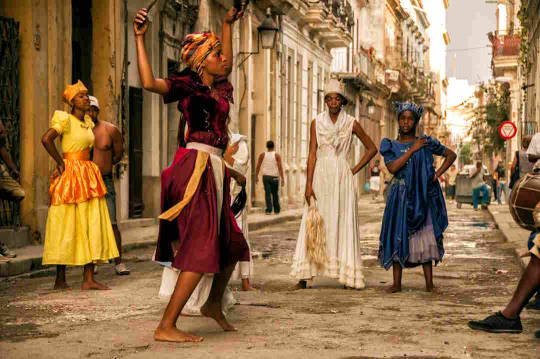
African sacred music in Cuba
All these African cultures had musical traditions, which survive erratically to the present day, not always in detail, but in the general style. The best preserved are the African polytheistic religions, where, in Cuba at least, the instruments, the language, the chants, the dances and their interpretations are quite well preserved. In few or no other American countries are the religious ceremonies conducted in the old language(s) of Africa, as they are at least in Lucumí ceremonies, though of course, back in Africa the language has moved on. What unifies all genuine forms of African music is the unity of polyrhythmic percussion, voice (call-and-response) and dance in well-defined social settings, and the absence of melodic instruments of an Arabic or European kind.
Not until after the Second World War do we find detailed printed descriptions or recordings of African sacred music in Cuba. Inside the cults, music, song, dance and ceremony were (and still are) learnt by heart by means of demonstration, including such ceremonial procedures conducted in an African language. The experiences were private to the initiated, until the work of the ethnologist Fernando Ortíz, who devoted a large part of his life to investigating the influence of African culture in Cuba. The first detailed transcription of percussion, song and chants are to be found in his great works.
There are now many recordings offering a selection of pieces in praise of, or prayers to, the orishas. Much of the ceremonial procedures are still hidden from the eyes of outsiders, though some descriptions in words exist.
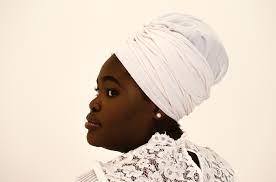
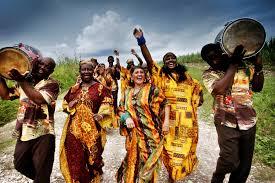
Yoruba and Congolese rituals
Main articles: Yoruba people, Lucumi religion, Kongo people, Palo (religion), and Batá
Religious traditions of African origin have survived in Cuba, and are the basis of ritual music, song and dance quite distinct from the secular music and dance. The religion of Yoruban origin is known as Lucumí or Regla de Ocha; the religion of Congolese origin is known as Palo, as in palos del monte.[11] There are also, in the Oriente region, forms of Haitian ritual together with its own instruments and music.
In Lucumi ceremonies, consecrated batá drums are played at ceremonies, and gourd ensembles called abwe. In the 1950s, a collection of Havana-area batá drummers called Santero helped bring Lucumí styles into mainstream Cuban music, while artists like Mezcla, with the lucumí singer Lázaro Ros, melded the style with other forms, including zouk.
The Congo cabildo uses yuka drums, as well as gallos (a form of song contest), makuta and mani dances. The latter is related to the Brazilian martial dance capoeira

#african#afrakan#kemetic dreams#africans#brownskin#brown skin#afrakans#african culture#fitness#afrakan spirituality#afro cuban music#afro cuban#igbo#yoruba#congo#african music
125 notes
·
View notes
Text
NEW SIGNING ALERT!!!

I am extremely pleased to announce that California/Philippines based Filipino artist Bo Razón Music has joined the HHR family, brining with him elements from AfroCuban, North American, Southeast Asian, Mediterranean, & West African cultures all blended into an eclectic ethnofusion 'global diaspora' stew.
Listen to and purchase the album at the link below. All sale proceeds go directly to the artist as always with HHR.
Remember to always support emerging artists!
#folk#world music#folk music#afro cuban music#african music#asian music#psychedelic folk#heritage harmony records#world fusion#Bandcamp
3 notes
·
View notes
Photo

Azteca by Azteca
Columbia Records
1972
Latin / Latin Rock / Soul-Jazz / Blues-Rock / Afro-Cuban Jazz / Jazz / Funk / Latin Folk / Latin Funk / Jazz-Rock
#latin#latin music#latin rock#rock#soul jazz#soul#soul music#jazz#blues rock#afro cuban jazz#afro cuban#afro cuban music#funk#latin folk#folk#folk music#latin funk#jazz rock#classic rock#music#70s#70s music#70's#70's music
13 notes
·
View notes
Text
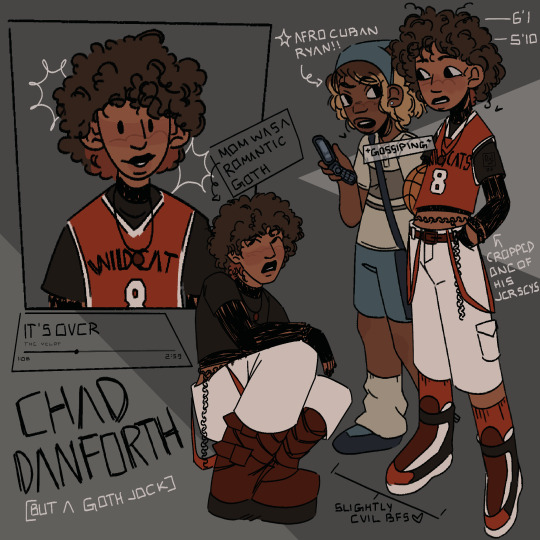
@ftm-megamind posted alternative chad and it took over my brain
#your mind is so huge im obsessed w this concept i fear#his mom is canonically a huge phantom of the opera fan#i could see her also being a romantic goth#i could see chad picking it up from her#goth-ish chad!!#also black ryan ofc but i was rewatching and bop 2 the top was a salsa so cuban ryan#the evans twins are afro cuban who’s gonna stop me#hes so prettayyy love him#chad danforth#high school musical#chyan#chad x ryan#ryan evans#hsm#dazndoodraws
361 notes
·
View notes
Text

Mambo trio. 🎹🎻🥁🎺🪘(mixed media collage)🎵
#descarga#salsa#salsa dancing#salsa music#mambo#maracas#clarinet#trumpet#jazz trumpet#jazz dance#jazz trio#jazz music#jazz club#jazz#latin jazz#afro cuban#latin music#drummer#double bass#bassi#jazz art#harlem renaissance#jazz age#jazz fusion#jam session#cotton club#apollo theater#cuban music#cuban history#jazzlovers
33 notes
·
View notes
Photo

Makuta performance in an old Kongo cabildo.
Source: Robin D. Moore - Fernando Ortiz on Music: Selected Writing on Afro-Cuban Culture (2018: 101)
18 notes
·
View notes
Text
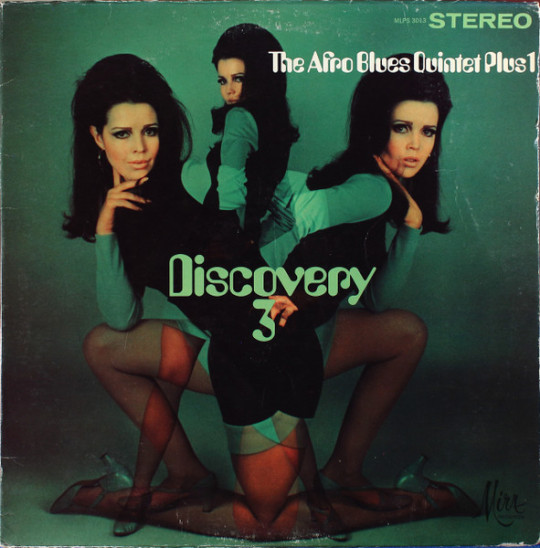
The Afro Blues Quintet Plus 1* – Discovery 3
Label: Mira Records – LPS 3013, Mira Records – MLPS 3013
Format:
Vinyl, LP, Album, Stereo
Country: US
Released: 1967
Genre: Jazz, Funk / Soul
Style: Afro-Cuban Jazz, Soul-Jazz, Mod
#weird album cover art#The Afro Blues Quintet Plus 1* – Discovery 3#vinyl albums#vinyl album cover art#album cover art#1967#1960s#60s#60s hair#60s fashion#60s make up#jazz#funk#soul#afro cuban jazz#soul jazz#mod music#women on album covers#late 60s
2 notes
·
View notes
Text
Bro you cant even escape the beatles in a documentary abt latin american/afro cuban music
#awesomepie3221#not that im trying to escape its jjst funny#learning abt afro cuban music then SLAM British dudes
19 notes
·
View notes
Photo

Willie Bobo in San Francisco by Martin Cohen (date unknown)
#im guessing 1960s tho??????#willie bobo#martin cohen#yes this dude is the father of eric bobo of cypress hill and beastie boys fame#music#musician#percussionist#jazz#latin jazz#american latin jazz#afro cuban jazz#rhythm and blues#drummer#1960s#60s#1970s#70s#hip hop#black and white#photography#ph#spit.post
14 notes
·
View notes
Text
Afro Cuban Funky Grooves with Cami Layé Okún
youtube
2 notes
·
View notes
Text

Spiritual jazz (or astral jazz)[1] is a sub-genre of jazz that originated in the United States during the 1960s. The genre is hard to characterize musically but draws from free, avant-garde and modal jazz and thematically focuses on transcendence and spirituality. John Coltrane's 1965 album A Love Supreme is considered landmark in the genre.

Origins
Pharoah Sanders in 1981.
Critics usually associate spiritual jazz with the 1960s but the beginnings of the genre can be traced to the 1940s and 1950s in works such as Black, Brown and Beige by Duke Ellington, Zodiac Suite by Mary Lou Williams, and Jazz at the Vespers by George Lewis.
During the 1960s in the United States, the civil rights movement was occurring, causing societal change and political movements. As a result, African-American people gained more freedom to celebrate their culture and to express themselves religiously. This led to a desire to push the conventions of jazz, with some artists choosing to search for transcendence and spirituality in their music.
John Coltrane's 1965 album A Love Supreme is generally considered the genesis of spiritual jazz though Coltrane can be heard developing the sound on the song "Spiritual" recorded four years earlier. Treblezine wrote "Spiritual jazz begins, essentially, with John Coltrane," while Pitchfork wrote "This musical exploration [of spirituality] was epitomized by tenor saxophonist John Coltrane". A Love Supreme and other works by John Coltrane inspired other jazz musicians to create music searching for transcendence. For example, Pharoah Sanders and Don Cherry were considered to have taken inspiration from Coltrane's spiritual works.
After John Coltrane's death in 1967, his wife Alice Coltrane and Sanders—both who had previously played with Coltrane—were some of the first to continue the sound of the genre. Coltrane's 1971 album Journey in Satchidananda combined spiritual jazz with influences from Hindustani classical music, after her journey into spirituality with help from Swami Satchidananda. Journey in Satchidananda used ragas, harps, sitars, and ouds to achieve its sound. Pharoah Sanders took inspiration from Arabic, Indian, and Afro-Cuban music to create early spiritual jazz albums, including Tauhid (1967) and Karma

#african#afrakan#kemetic dreams#africans#brownskin#afrakans#brown skin#african culture#afrakan spirituality#jazz spirituality#spiritual jazz#afro cuban music#pharoah sanders#tauhid#journey in satchidananda#ragas#harps#sitars#ouds#Kamasi Washington#alice coltrane#duke ellington#miles davis#african music
45 notes
·
View notes
Text
#music#jazz#Cuban jazz#afro cuban#Afro Cuban jazz#Mississippi mambo#mambo#songs#bebo valdes#SoundCloud
2 notes
·
View notes
Text
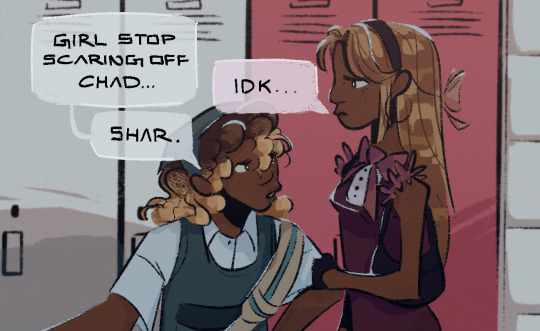
why yes! i am using ryan and sharpay as an excuse to look at runways from 2005



#dries van noten’s spring collection is so ryan in my head#sharpay WOULD be a chanel girl i must speak my truth#tall sharpay tall sharpay#afro cuban evans twins is canon dw about it#ryan 🤝 chad + sharpay 🤝 taylor#they’re all such horrible gossips (they cause the problems they gossip about)#shar strikes fear into chad’s heart mostly for fun#he thinks she’s plotting on the downfall of chyan (she isn’t but she’s not gonna tell them that)#dazndoodraws#ryan evans#sharpay evans#high school musical#sharpay and ryan#hsm
15 notes
·
View notes
Photo
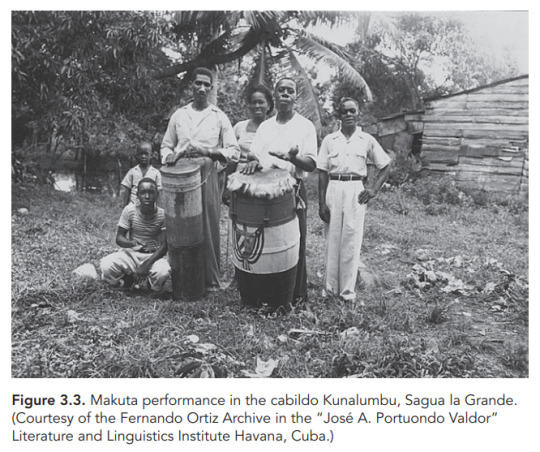
Makuta performance in the cabildo Kunalumbu.
Source: Robin D. Moore - Fernando Ortiz on Music: Selected Writing on Afro-Cuban Culture (2018: 106)
4 notes
·
View notes
Text
Mongo Santamaria
Feliz cumpleaños, Ramón "Mongo" Santamaría Rodríguez!
youtube
0 notes